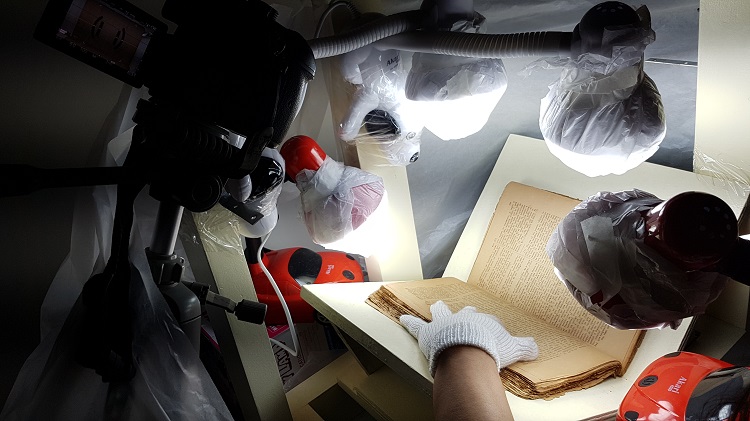
DIGITIZING DOCUMENTS. One of the historical documents archived within the Museo de Oro, Xavier University - Ateneo de Cagayan’s museum, is being digitized for preservation. Proper lighting is used for the process. Supplied photo.
Remembering the past is one way to understand the present and to be aware of the possibilities the future holds.
The Xavier Center for Culture and the Arts (XCCA), Xavier University - Ateneo de Cagayan’s organization for cultural and artistic programs, initiated Handuraw sa Kinaadmanong Bahandi sa Mindanao (Image of the Treasured Wisdom of Mindanao), a digitization project of the archival collections of Museo de Oro.
Recalling the olden days of Northern Mindanao involves preserving documents that contain records of relevant periods in the region’s history it is also a way to store selected historical documents within the university’s museum.
Funded by the National Commission for Culture and the Arts (NCCA), through the Subcommission on Cultural Heritage, the project encompasses scanning and taking of photos of the contents of the documents before transferring them into the computers for storage.
“These [documents] have local, regional, and national value because of their historical, cultural, and heritage significance,” XCCA director Hobart Savior stated in an academic forum last September within the university campus where he presented the progress of the project. Savior also authored the project’s proposal to the NCCA.
Periods in history
The archived documents span from the Spanish colonization of the Philippines to the American occupation and the pre-Second World War era.
These include newspapers circulated across Camiguin and CDO decades before the latter was chartered as a city in the 1950s; books covering the legal bases that govern the Philippine islands during the Spanish colonization period; volumes where religious rites and sacraments that were presided in Camiguin, Jasaan, and Tagoloan municipalities to convert residents had been recorded; and epics from indigenous tribes around the region.
Some of these documents – such as the epics – had been collected by the late Fr Francisco Demetrio SJ, the founder of the university’s 51-year-old Museo de Oro.
To ensure all this will endure and sustain their contents, modern technology has been utilized as the need suits it despite the gradual and eventual decay of their original tangible copies.
“We are in the digital age, and we have to preserve and protect our archives here in Museo de Oro for the purpose that they can be availed and accessed by many,” Savior noted.
For education and awareness
Collaborating with the NCCA for this initiative, the project began in July after the National Committee on Archives representative Rosemarie Roque conducted a proper training on how to appropriately digitize historical documents.
With the consultation of Museo de Oro archivist Irene Llesis, the team employed by XCCA conducted the process within the museum by using the right equipment.
As of the first week of October, 85% of progress has been accomplished, with completion slated by the end of the month.
XCCA plans that after these documents have been fully digitized, their electronic copies are projected to be shared witth the academic community and the general public in Northern Mindanao.
“This project ensures availability and accessibility of the digitized materials [and documents] to the public as well as to the educational institutions for the purpose of heritage promotion and awareness,” Savior said.
With the digitization on the works, the project opens the possibility that anyone interested in recalling the past to understand the present can utilize technology and perceive history in a new light.∎ (By Angelo Lorenzo)